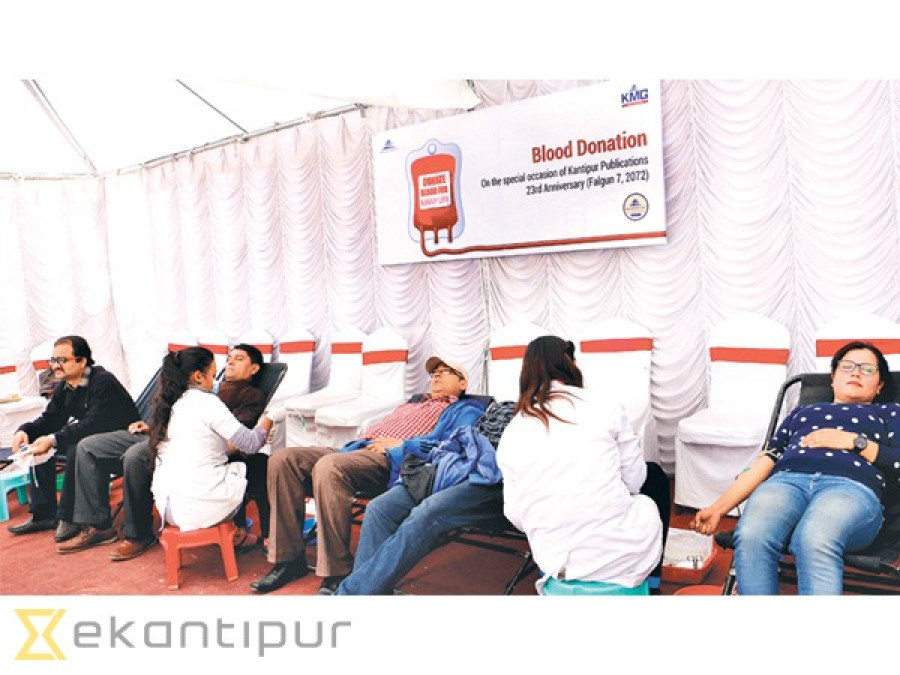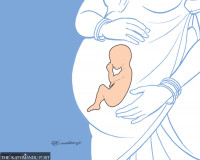Health
Kathmandu’s blood banks are running out of blood.
The last several years have seen a major decline in blood donations, leading blood banks to struggle to manage blood for patients.
Arjun Paudel
On April 16, Mina Kumari Chhetri had to urgently admit her one-year-old daughter Hritika Kunwar to undergo valve replacement surgery at the Shahid Gangalal National Heart Centre. The doctors told her that her daughter was suffering from a congenital heart defect and needed to undergo immediate surgery to prevent blood leakage. Chhetri was asked to arrange for six pints of fresh AB positive blood before her daughter could even get admitted to the hospital. The doctors emphasised that they could only start surgery after the blood had been arranged.
“We could not arrange a single pint of blood. I do not know whether our baby will gain admission,” said Mina Kumari, who had travelled to the capital from Nisikhola Rural Municipality of Baglung District.
Mina Kumari approached the Central Blood Transfusion Service, popularly known as the central blood bank, operated by the Nepal Red Cross Society. But there was no blood to be had. Moreover, staff at the blood bank asked her to arrange donors by herself. She visited more blood banks, only to be told the same thing.
“My blood group is O positive, her grandmother has already undergone two surgeries and cannot donate blood. And we do not know the blood group of her mother,” Hritika’s maternal uncle Khagendra Bahadur Chhetri said. “How can we arrange blood donors in this unknown city?”
Doctors at the hospital said that there were two holes in Hritika’s heart, said Khagendra. This was leading her to frequently vomit and hyperventilate. Hritika’s father is in Qatar for employment and it was her mother, grandmother and maternal uncle who had brought her all the way to Kathmandu for treatment.
Hritika’s isn’t the only case where major surgeries are often put on hold due to a lack of blood. Everyday, hundreds of people visit blood banks in the capital, looking for blood for their friends and family members undergoing critical surgeries. Most return empty-handed.
The last several years have seen a major decline in blood donations, leading blood banks to struggle to manage blood for patients.
Chokat Sahani has also been scouring blood banks in the capital for his nephew Santosh Sahani, who was critically injured in a road accident in Jotpur village of Pheta Rural Municipality in Bara district. Santosh is currently undergoing treatment at B & B Hospital in Lalitpur, and the doctors have already transfused seven pints of AB negative blood. They’ve asked for more.
“We do not know anyone in Kathmandu to ask for blood and the blood banks have asked us to find donors on our own,” said Chokat. “We are in big trouble.”
Running out of options, and money, Chokat has sent relatives back to his village to arrange for a loan for his nephew’s treatment. But even if they return with money, it is still uncertain how they will secure the amount of blood required.
Generally, the staff at blood banks ask relatives of patients to provide the bank with a replacement, even if they have blood in stock.
“People from outside the Valley find themselves in big trouble if their relatives are admitted to hospital and need blood,” said Prem Sagar Karmacharya, president of the Nepal Voluntary Blood Donors’ Society. “At least people residing in the Valley can find their own donors, but chances are thin for those who’ve travelled here from various parts of the country.”
In the past, only negative blood groups were scarce at the blood bank and staffs would only ask for a replacement of a few blood groups, said Karmacharya. But recently, banks have been facing a critical shortage of all blood groups.
There’s been a blood crisis for some time now, said Dr Manita Rajkarnikar, director of the Central Blood Transfusion Service. “Donations have declined when compared to soaring demands,” she said.
The central blood bank regularly conducts blood donations camps at Bhrikutimandap, Bhugol Park and Ason to deal with the shortfall, but this hasn’t solved a fraction of the problem. Such collection centre collects three pints, five pints and 15 pints in maximum and sometimes not even a single pint, according to Rajkarnikar.
Both Rajkarnikar and Karmacharya agree that blood donation campaigns have faced a sharp decline in the last few years. An increasing number of young healthy donors leaving the country for foreign employment, along with a rise in patients with high blood pressure, blood sugar, and thyroid—who are ineligible to donate blood— has led to current state of affairs, said officials at the bank.
“Many people also shrug off blood donation if the blood bank fails to provide blood during their emergencies,” Karmacharya said.
Measures to manage crisis
According to Rajkarnikar, her office has requested social organisations, financial institutions and other professional organisations to organise blood donation programmes on working days, at least twice a year.
But most institutions organise blood donation programmes only on their anniversaries, which she said was not sufficient to manage the growing crisis. “Hundreds of young people are working in a single institution. If they organise a donation programme twice a year, it would be great relief for us,” said Rajkarnikar.
The Bhaktapur blood bank, meanwhile, has been managing the supply of blood by reaching out to Dolakha, Sindhupalchowk, Ramechhap and other adjoining districts. So far, according to Manoj Thapa, chief of the Bhaktapur blood bank, they’ve managed to supply blood to everyone who has visited them. The blood bank, also run by the Nepal Red Cross Society, said that it has been supplying 175 pints of blood a day.
“Due to the failure of the central blood bank to supply blood, demands have increased at our blood bank,” said Thapa.
The slogan for the Bhaktapur blood bank is, “Come to Bhaktapur if you are denied blood,” which is apt for the organisation which has been contributing a lot to manage the growing crisis.
But in order to have a sustainable solution to the problem, it is important to make use of current technology as well—specifically, the maintenance of a digital databank of blood donors, said Rumee Singh, founder and chief executive officer of Hamro Life Bank.
Hamro Life Bank has been working with bloods banks to build a database of donors in the Valley. According to Singh, this data bank can help ease growing demands for blood, since it would make it easier to access the information of blood donors and reach out to them.
If such a database grows large enough, perhaps people like Mina Kumari will not have to search the city for a suitable blood donor just so that their one-year-old child can undergo a life-saving surgery.




 12.88°C Kathmandu
12.88°C Kathmandu














